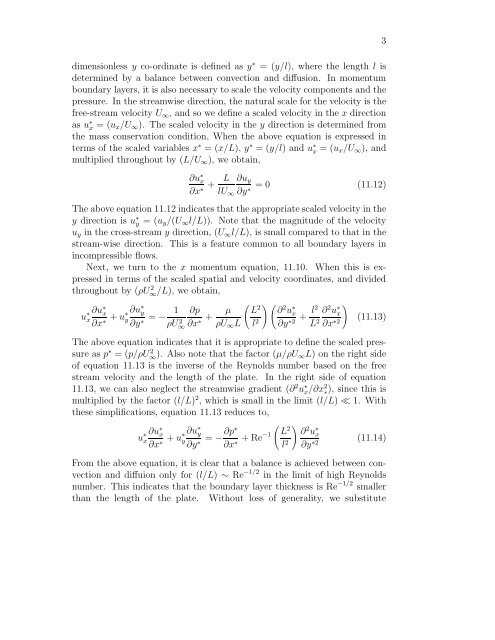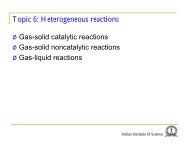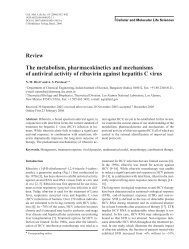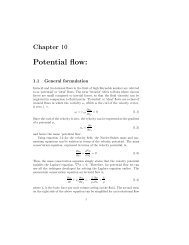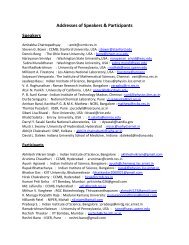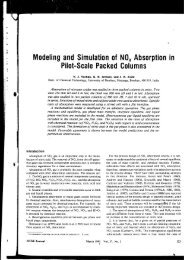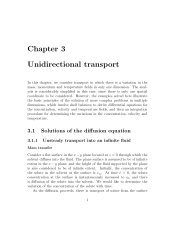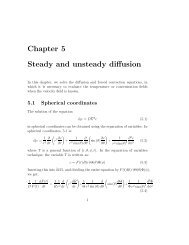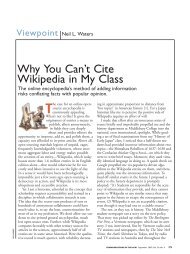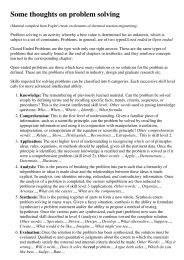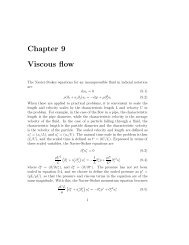Chapter 11 Boundary layer theory
Chapter 11 Boundary layer theory
Chapter 11 Boundary layer theory
You also want an ePaper? Increase the reach of your titles
YUMPU automatically turns print PDFs into web optimized ePapers that Google loves.
dimensionless y co-ordinate is defined as y ∗ = (y/l), where the length l is<br />
determined by a balance between convection and diffusion. In momentum<br />
boundary <strong>layer</strong>s, it is also necessary to scale the velocity components and the<br />
pressure. In the streamwise direction, the natural scale for the velocity is the<br />
free-stream velocity U ∞ , and so we define a scaled velocity in the x direction<br />
as u ∗ x = (u x/U ∞ ). The scaled velocity in the y direction is determined from<br />
the mass conservation condition, When the above equation is expressed in<br />
terms of the scaled variables x ∗ = (x/L), y ∗ = (y/l) and u ∗ x = (u x/U ∞ ), and<br />
multiplied throughout by (L/U ∞ ), we obtain,<br />
∂u ∗ x<br />
∂x ∗ + L<br />
lU ∞<br />
∂u y<br />
∂y ∗ = 0 (<strong>11</strong>.12)<br />
The above equation <strong>11</strong>.12 indicates that the appropriate scaled velocity in the<br />
y direction is u ∗ y = (u y /(U ∞ l/L)). Note that the magnitude of the velocity<br />
u y in the cross-stream y direction, (U ∞ l/L), is small compared to that in the<br />
stream-wise direction. This is a feature common to all boundary <strong>layer</strong>s in<br />
incompressible flows.<br />
Next, we turn to the x momentum equation, <strong>11</strong>.10. When this is expressed<br />
in terms of the scaled spatial and velocity coordinates, and divided<br />
throughout by (ρU∞ 2 /L), we obtain,<br />
u ∗ ∂u ∗ x<br />
x<br />
∂x + ∂u ∗<br />
∗ u∗ y<br />
y<br />
∂y = − 1 ∂p<br />
∗ ρU∞<br />
2 ∂x + µ ( ) ( L<br />
2 ∂ 2 u ∗ x l2 ∂ 2 u ∗ )<br />
x<br />
+ (<strong>11</strong>.13)<br />
∗ ρU ∞ L l 2 ∂y∗2 L 2 ∂x ∗2<br />
The above equation indicates that it is appropriate to define the scaled pressure<br />
as p ∗ = (p/ρU∞ 2 ). Also note that the factor (µ/ρU ∞L) on the right side<br />
of equation <strong>11</strong>.13 is the inverse of the Reynolds number based on the free<br />
stream velocity and the length of the plate. In the right side of equation<br />
<strong>11</strong>.13, we can also neglect the streamwise gradient (∂ 2 u ∗ x /∂x2 ∗ ), since this is<br />
multiplied by the factor (l/L) 2 , which is small in the limit (l/L) ≪ 1. With<br />
these simplifications, equation <strong>11</strong>.13 reduces to,<br />
u ∗ ∂u ∗ x<br />
x<br />
∂x ∗ + u∗ y<br />
∂u ∗ y<br />
∂y ∗ = −∂p∗ ∂x ∗ + Re−1 ( L<br />
2<br />
l 2 ) ∂ 2 u ∗ x<br />
∂y ∗2 (<strong>11</strong>.14)<br />
From the above equation, it is clear that a balance is achieved between convection<br />
and diffuion only for (l/L) ∼ Re −1/2 in the limit of high Reynolds<br />
number. This indicates that the boundary <strong>layer</strong> thickness is Re −1/2 smaller<br />
than the length of the plate. Without loss of generality, we substitute<br />
3


